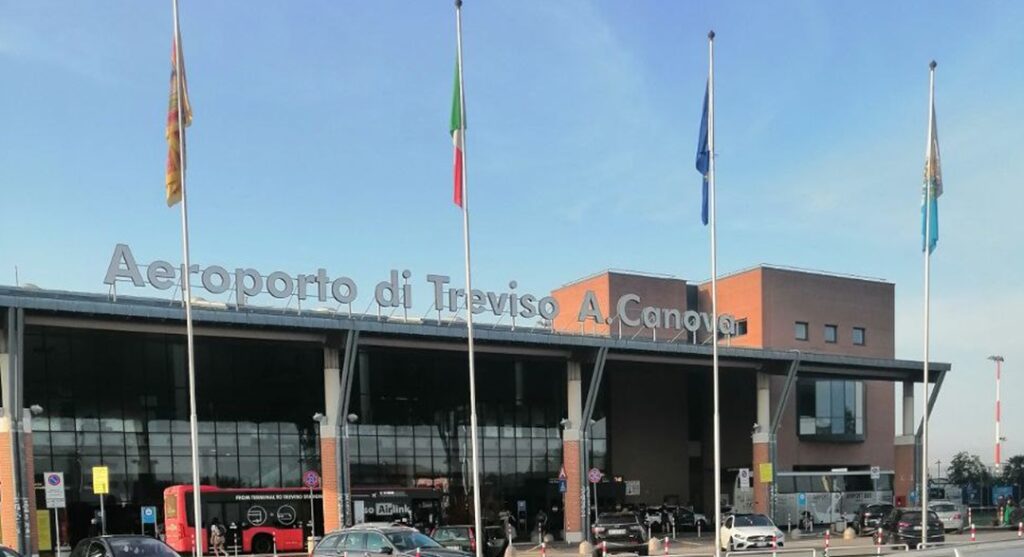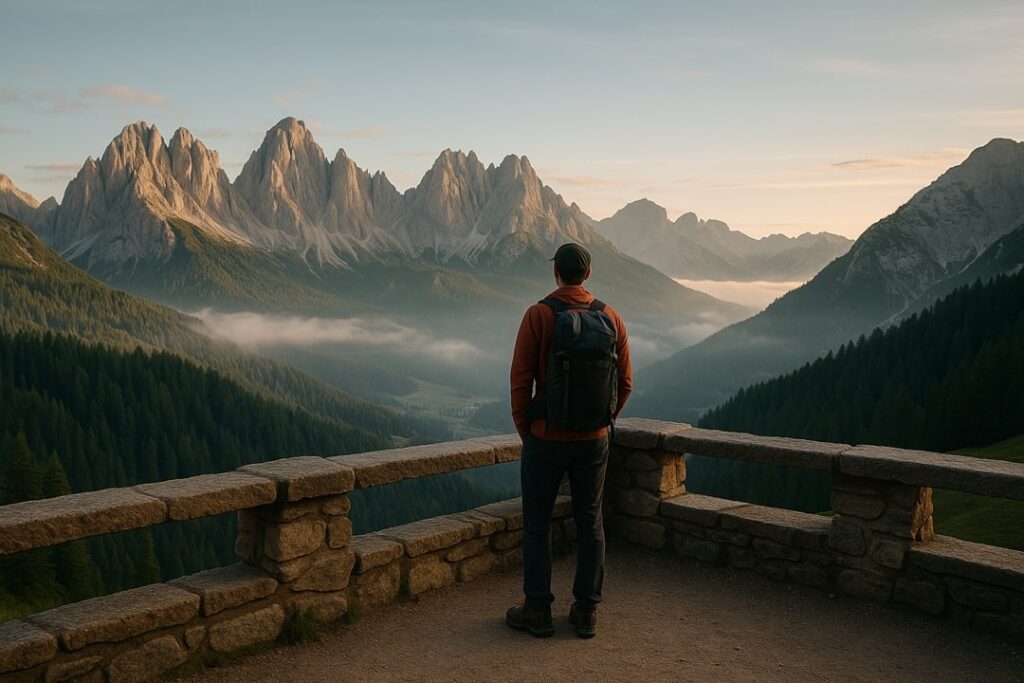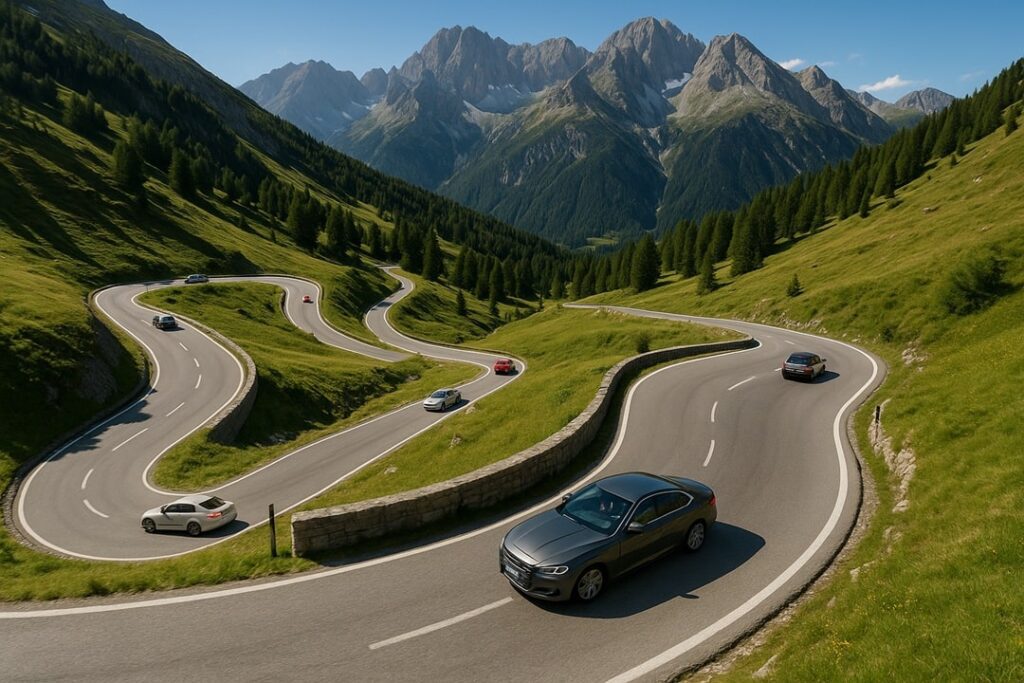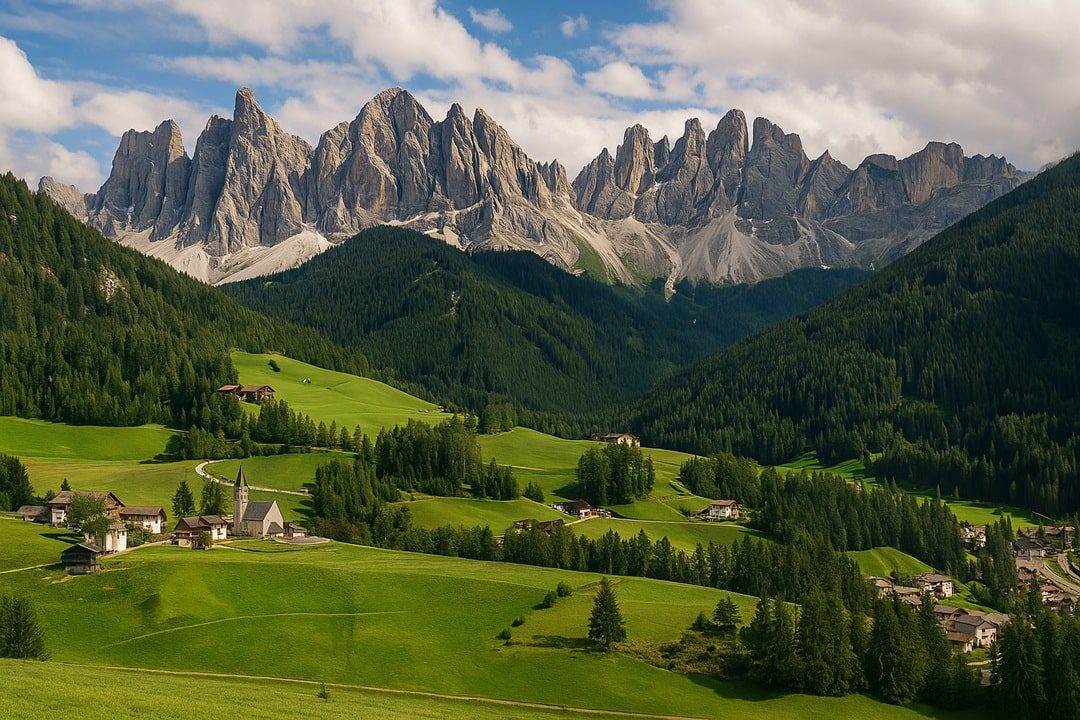First Glimpse of the North — Where Italy Turns Vertical
The moment it happens is quiet. You’re on a train or in a car, winding your way north through the gentle curves of the Italian countryside — hills, vineyards, a church spire here and there — and then, suddenly, the land lifts. It doesn’t rise politely. It erupts. Jagged peaks tear across the horizon, snow still clinging to their tops even in June. It feels like the country just changed languages mid-sentence.
This is where Italy becomes something else.
The air smells different here — cleaner, sharper, like stone and wood and cold water. People speak German in one town and Ladin in the next, but the coffee is still Italian, strong and small and exactly right. The houses have flower boxes spilling color over carved wooden balconies. The roads curve like calligraphy. Everything feels deliberate, but never rushed.
There’s something older about these mountains. They don’t seem designed for tourists — not exactly. They seem like they were always here, waiting for someone to walk quietly into them.
You don’t feel like a visitor in the Italian Alps. You feel like a guest. The kind that’s welcomed, but expected to listen — to the silence, to the snow, to the way bells echo between the peaks on a slow afternoon.
The first time you see them, it’s impossible not to stare. The second time, you bring boots.
The Grand Peaks and the Valleys Between Them
Dolomites — Where Stone Becomes Sculpture
The Dolomites don’t just rise; they erupt. Their jagged peaks, glowing pink at dusk, seem sculpted by time and light. Exploring this region isn’t just about reaching destinations; it’s about the journey through winding roads, alpine meadows, and serene lakes.
To truly experience the Dolomites, having the flexibility of your own vehicle is invaluable. Opting for a car rental allows you to venture off the beaten path, discovering secluded spots and picturesque villages at your own pace.

Treviso Airport (TSF) serves as a convenient gateway to the Dolomites. Several reputable car rental companies operate here.
- Europcar: Offers a wide range of vehicles suitable for mountainous terrains.
- Sixt: Known for its premium fleet and excellent customer service.
- Budget: Provides competitive rates and a variety of car options.
- Hertz: Offers reliable vehicles and flexible rental terms.
As of recent data, rental prices at Treviso Airport are approximately
- Economy cars: Starting from $44 per day.
- Compact SUVs: Around $68 per day.
- Luxury vehicles: Up to $188 per day.
Booking in advance is recommended to secure the best rates and ensure availability, especially during peak travel seasons.
With your own vehicle, you can explore iconic landmarks such as the Tre Cime di Lavaredo, the serene Lake Braies, and the charming town of Cortina d’Ampezzo. Each turn offers a new vista, each stop a new story.
Moving Through the Mountains — The Joy Is in the Journey

Trains, Hairpin Roads, and Renting a Car
There’s something different about movement in the Italian Alps. It’s not about getting from A to B. It’s about everything in between. The space between villages. The pause before a tunnel. The way the light shifts when you climb a few hundred meters up a mountainside. Traveling here isn’t just necessary — it’s part of the experience.
Trains do run in the Alps — especially through the more developed valleys near Trento or Bolzano — and they’re punctual, clean, and scenic. But they only take you so far. The moment you want to stop at a trailhead just because the sky broke open and the light hit the peaks just right — well, that’s when trains stop helping. That’s when you understand the quiet genius of renting a car.
It’s not about luxury. It’s about control. When the mood shifts, when the clouds roll in, or when a local in a mountain village tells you about a lake «just twenty minutes that way,» you don’t want to be stuck waiting for a bus. You want to go.
Driving here is never boring. The roads are serpentine and deliberate, clinging to mountainsides like someone carved them by hand. You’ll pass through tunnels that feel like time machines and emerge into valleys where cows outnumber people. You’ll stop for espresso in gas stations that serve better food than some restaurants in Milan.
The rhythm of the Alps isn’t fast — but it is sharp. Everything has a purpose, even stillness. With your own wheels, you get to choose the pauses, the detours, the overlooks that aren’t marked on any map.
And sometimes, that’s where the trip really begins.
Waking Up in South Tyrol
The morning here feels untouched. You open a wooden shutter, and the sky is still warming up. The mountains aren’t shouting — they’re just there, solid and still, like old friends who don’t need to speak to be heard. You hear cowbells somewhere below, a baker sweeping his stoop, a dog barking once, then silence again.
You’re in South Tyrol — a place that doesn’t quite belong to any one country. The signs are in three languages. The architecture is part Austrian chalet, part Italian villa. The markets sell prosciutto and strudel in the same stall, and nobody finds that strange.
In a small town like Ortisei or Castelrotto, the day unfolds slowly. You sip coffee on a balcony and watch clouds shift over the peaks like ink swirling in water. The landscape here isn’t just beautiful — it’s deliberate. Terraced vineyards. Wooden barns. Trails that look like they’ve been used for centuries.
This part of the Alps feels more intimate, more lived-in. You don’t just visit here. You stay. You settle in. You learn the name of the man who makes cheese behind the church. You learn the rhythm of the weather, the difference between the morning mist and the afternoon haze.
If you’ve chosen to rent a car, you can dip between valleys on your own terms — from Bolzano’s shaded streets to alpine meadows above Alpe di Siusi, where the silence feels endless. The roads curve gently through orchards and old bridges, past vineyards that look like they shouldn’t grow on such steep ground, and lakes that flash green when the sun breaks through.
By the time evening rolls in, the day feels full — not with activities, but with presence. With space. With that quiet kind of happiness that comes from knowing you’ve seen a place as it is, not just as it’s shown.
Towns, Fortresses, and Sacred Heights
Bormio and the Thermal Legacy of the Romans
You walk into the water, and it’s warm like memory. The valley around you is still cold — snow lingers on the rooftops, the air smells like pine and rock — but the water embraces you. This is Bormio, and people have been soaking here for more than two thousand years.
You can feel it in the stones. Not just in the baths themselves, but in the town: cobbled lanes, faded murals, arches that don’t bother explaining themselves. This was once a Roman outpost, but it never tried to outgrow its purpose. It just kept welcoming the tired and the cold.
There’s a certain humility in Bormio. It’s not showy. It doesn’t need to be. The steam rising from ancient pools says more than any travel ad ever could.
The Sacra di San Michele and Valleys of Faith
You see it long before you arrive — the abbey perched impossibly high, as if daring the wind to move it. The Sacra di San Michele stands on a rocky outcrop above the Susa Valley, silhouetted against the sky like something out of myth. But it’s real. Stone. Silence. Prayer.
The climb up is steep, whether by foot or winding mountain road. But as you rise, so does something inside you. This place doesn’t feel manmade. It feels chosen. The way the light hits the walls. The way the air shifts near the altar. You don’t need to believe in anything specific to feel reverence here — it just happens.
Below, the valley spreads out like a soft green sea. Towns blink in the distance. The train line looks like a silver thread. You stand between past and present, between earth and sky, and you’re not quite sure where you belong. And maybe that’s the point.
Castles That Guarded the Borders
In these mountains, castles don’t feel like fairy tales. They feel like memory — defensive, practical, weatherworn. They were built to see the enemy coming, to send signals across valleys, to protect not just land but people.
Castel Beseno. Forte di Fenestrelle. Castello di Tures. They’re not on the usual itinerary. But when you walk their courtyards, climb their towers, and run your fingers over the grooves left by centuries of boots and blades, you feel history breathing a little louder.
They remind you that these mountains were once barriers — not just for armies, but for ideas, for language, for culture. And yet here they are, still standing, still holding their place in the story.
Seasons in the Alps — From Powder to Meadows

The Stillness of Summer
Summer here isn’t loud. It arrives gently, like a window being opened. The snow retreats, but not all at once — it lingers in the shadows, as if reluctant to leave. Meadows take their place, stretching out like patchwork quilts stitched with wildflowers. The air feels washed. Even the colors seem to pause, soft and deep.
You walk through pastures where cows move slowly under the sun, their bells echoing like punctuation in the quiet. You pass wooden huts where someone is slicing cheese just made that morning. Trails weave into the woods, and then out again into sudden light. You stop not because you’re tired, but because you want to see what happens when you stand still.
Summer here isn’t about ticking off hikes or chasing peaks. It’s about listening. About lying in the grass and watching clouds spill over ridges like they forgot how to hold their shape.
Everything slows — and in that slowness, you feel more awake than ever.
When Winter Arrives, Everything Changes
And then, without fanfare, it shifts.
Winter doesn’t knock in the Italian Alps. It steps inside and closes the door behind it. The trees harden. The paths vanish. Villages quiet down to the sound of snow being shoveled and wood being stacked. The air carries the smell of fire and frozen earth.
Ski towns come alive, but not in a frantic way. There’s movement — boots clattering, laughter in the lift lines, steam rising from mugs on chalet terraces — but beneath it all is a deep hush. A kind of reverence for how small we are in the presence of so much white.
Evenings stretch. Fires crackle. People speak more softly. Maybe it’s the cold. Maybe it’s the weight of the dark outside the window. Or maybe it’s the realization that in these months, everything becomes more essential — the warmth of soup, the comfort of a thick sweater, the way light pools on a table like something rare.
You don’t come to the Alps just for scenery. You come for this rhythm. The slow inhale of summer. The deep exhale of winter. The knowledge that neither asks anything of you — except to notice.
The Italian Alps Don’t Need to Shout
Some places ask to be photographed. Others ask to be remembered. The Italian Alps do neither — they simply are. They rise, they hold, they wait. And when you’re there, really there, you feel something shift. Not dramatically. Not loudly. But definitely.
You don’t need to conquer these mountains. You don’t even need to understand them. It’s enough to walk a trail until it disappears in snow. To sit at a wooden table where someone serves you bread without saying much. To wake up in a room with a view you forgot to draw the curtain across the night before.
The Alps don’t perform. They don’t glitter. They don’t pitch themselves in brochures. But if you let them, they’ll get under your skin in the gentlest, most persistent way. And long after you’ve left — after your gear’s unpacked and your shoes are back in a closet — you’ll find yourself standing at a window somewhere, thinking about light. About stone. About silence that breathes.
You won’t be able to explain it. You won’t need to.
